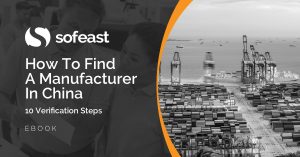I realized that most buyers are unfamiliar with their options when it comes to sourcing manufacturers. I want to clarify what their options are.
(This is especially applicable if you import electrical and/or mechanical products from China, Vietnam, Thailand, Malaysia, and Taiwan).
The three types of manufacturers
You may have already come across these acronyms for the different manufacturers. Here is a brief summary of each:
1. ODM (Original Design Manufacturer)
They design and make a product. They own the intellectual property (IP) rights of that product. They allow their customers to slap a logo on their product and/or to make small adjustments to the product.
2. OEM (Original Equipment Manufacturer)
You come up with a design, you go and see them because they are already in that product space, and they develop your product based on their existing technical knowledge, their supplier relationships, and so on. They generally don’t invoice for the engineering time and for the sourcing work. They typically own the IP and don’t disclose who makes the components.
3. CM (Contract Manufacturer)
You come up with a design, too, but they are more transparent. You expect them to work on your project in a more professional manner, you pay for their work, and you own all the IP (including all the latest drawings and schematics, the tooling, the bill of material, and so forth).
A video to explain how to make the right sourcing decision
I shot this video this morning in order to represent the 3 options when sourcing manufacturers in China and beyond and their ‘sweet spots’ in classic 2×2 matrices, in 2 situations:
- You design your own product
- You buy an existing product off-the-shelf
Rules of thumb: who should you work with?
First, work with a company for whom you represent between 5% and 50% of the annual output. (These numbers might vary wildly based on your philosophy, but the idea is to have sufficient weight for them to try and please you while keeping room for growth and not becoming solely responsible for their financial destiny.)
Second, you will tend to work with an ODM if your orders are small and you don’t need much control over your supply chain, and at the other extreme, you will tend to work with a CM if you have large orders and you want a lot of control.
Third, you need to be aware of the incentives of your manufacturer.
Many companies work with an OEM factory for large production runs but run into issues that impact quality, delivery time, and cost. Why? Simply because the OEM business model implies that there is no incentive to spend the time to do all the engineering work needed to minimize risks in mass production.
Basically, if they can’t describe their new product development process, it means they don’t have such a process… and you should not develop a new product with them!
Fourth, I should mention trading companies. Some of them (maybe 5% or 10%) really add value. Make sure they don’t hide the realities of the manufacturer actually making the products.
I have written before about some of the ‘dirty secrets’ of trading companies and why first-timers are more likely to fall for them.
Do you want to hear a longer conversation on the topic of finding the right manufacturer for your needs?
Listen to this episode of our podcast for an hour of discussion which will be really useful when sourcing manufacturers in China, Vietnam, or elsewhere. Not only do I share key benefits and drawbacks for the manufacturers you may choose to supply you, but I’ll also explain the types of volumes that dictate which is a better fit and tips on how best to protect your business and your IP when working with OEMs and ODMs.
*****
How about you? Which type of manufacturer are you working with, or perhaps you set up your own manufacturing facility in order to get the best results? Have you had any troubles with your supplier? What worked out really for you? Please share your experiences or questions by leaving a comment.
Are you trying to find a manufacturer in China who is well-suited to your needs and can also deliver on their promises?
Sofeast has developed 10 verification steps to help importers find the right manufacturing partner in China. They’re shared in this FREE eBook: “How To Find A Manufacturer In China: 10 Verification Steps.”
It covers:
- Background checks
- Manufacturing capabilities
- Quality system auditing
- Engineering resources
- Pricing, negotiation, & contracts
- …and much, much more
Just hit the button below to get your copy and put yourself in a great position to get better results from Chinese manufacturers who supply your products:


